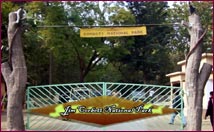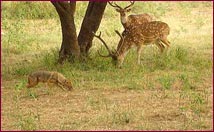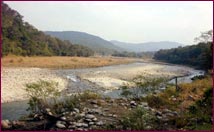Home of the roaring tiger, trumpeting elephant and the warbling birds, the park has earned the name "Land of Roar, Trumpet and Song". Locale of Jim Corbett's books, and F.W. Champion's famous photographs of the tiger, taken in the nineteen twenties, nature has also been lavish with its gifts of wildlife. The Corbett tigers reserves has a quite a history . It is India's first National Park and one of the most finest , notable for its individualistic scenic charm and magnificient submontaneand riverine vistas , and also for its richely varied wildlife , still interestingly in the process of change , and the site of the launching of Project Tiger.
 Presenting
a scene of remarkable beauty, nestling in the foot-hills of
Uttaranchal, is the Patlidun, a broad flat valley, where the
bubbling, rushing water of the river Ramganga meander through the
hills and dales. Here Nature has spared no efforts against the green
and coppery foliage of the forest of Sal, she has spread a carpet of
the glowing red flowers of the Flame of the Forest, the delicate
drapery of ferns and creepers and the waving tiger grass producing
an unforgettable scene of grandeur, while the colourful birds, lost
in ethereal song, add to the enchantment. Although the Sal timber is
felled and extracted in certain parts, the natural beauty of the
area has remained unimpaired, particularly
Presenting
a scene of remarkable beauty, nestling in the foot-hills of
Uttaranchal, is the Patlidun, a broad flat valley, where the
bubbling, rushing water of the river Ramganga meander through the
hills and dales. Here Nature has spared no efforts against the green
and coppery foliage of the forest of Sal, she has spread a carpet of
the glowing red flowers of the Flame of the Forest, the delicate
drapery of ferns and creepers and the waving tiger grass producing
an unforgettable scene of grandeur, while the colourful birds, lost
in ethereal song, add to the enchantment. Although the Sal timber is
felled and extracted in certain parts, the natural beauty of the
area has remained unimpaired, particularly Favourite of Hunters
Dhikala got its name, probably from the words 'clump of earth', and Boxar from the Boxas that inhabits the place. The Patlidun became a favourite hunting spot. Tigers, in large numbers, roamed the foot-paths, roads and dry river beds during all hours of the day in the South Patlidun. Wild game hunters came on 'safaris' from all parts of the world to go tiger hunting. One such was Jim Corbett, always engrossed in animals, as a boy, he would go with the 'shikaris' to show them the area but soon, himself, mastered the gun. He became an avid hunter, but inherent in him was a deep love for all animals, including tigers.
 Sir
Johns Hewett, Lt. Governor of United Provinces, at the
suggestion of James Corbett, decided to establish a wildlife park.
On 8th August, 1936, the park opened under the name Hailey
National Park, after the Governor of the United Provinces, now
Uttar Pradesh (UP.) - Sir Malcom Hailey. Later it was changed to the
Ramganga National Park in 1952. In 1957, it was finally re-named
as "Corbett National Park" in honour and memory of the
late "Jim Corbett", the legendary hunter. Jim Corbett had
in the meantime, became world-famous through his book "Man
Eaters of Kumaon". Corbett and with his dedication to the
study of the fauna of the Kumaon foothills, became a foremost,
prominent protagonist of wildlife, whose, he pleaded in his books.
Sir
Johns Hewett, Lt. Governor of United Provinces, at the
suggestion of James Corbett, decided to establish a wildlife park.
On 8th August, 1936, the park opened under the name Hailey
National Park, after the Governor of the United Provinces, now
Uttar Pradesh (UP.) - Sir Malcom Hailey. Later it was changed to the
Ramganga National Park in 1952. In 1957, it was finally re-named
as "Corbett National Park" in honour and memory of the
late "Jim Corbett", the legendary hunter. Jim Corbett had
in the meantime, became world-famous through his book "Man
Eaters of Kumaon". Corbett and with his dedication to the
study of the fauna of the Kumaon foothills, became a foremost,
prominent protagonist of wildlife, whose, he pleaded in his books.
The Rites of Spring
In spring-time, the Entire area presents a beautiful panorama-the sprouting 'sheesham' leaves, the gorgeous scarlet flowers of semal the mauve blooms of kachnar mingle into a psychedelic riot of colour, reflected in the sparkling waters of the Ramganga, and few places can equal this shimmering scene of Nature 'out to conquer' while the myriad varieties of exotic birds in their colourful spring plumage, help by adding their charm and filling the air with melodious song.
Fauna of the Park
 Here
are found wild elephants, leopards, hyenas, jackals and wild dogs.
There are also some magnificent hog deer, barking deer, sambhar,
chital and bears, both sloth and Himalayan. There is an occasional
serow and some gural, mongooses, palm squirrel, flying squirrel,
ratel, wild cat, antelopes, deer, wild boar, otter and porcupine.
Here
are found wild elephants, leopards, hyenas, jackals and wild dogs.
There are also some magnificent hog deer, barking deer, sambhar,
chital and bears, both sloth and Himalayan. There is an occasional
serow and some gural, mongooses, palm squirrel, flying squirrel,
ratel, wild cat, antelopes, deer, wild boar, otter and porcupine.There are eight watch towers in the park and elephants are available in Dhikala and Bijrani to view the wonders from November to June.
The Glories of the Ramganga
Coming from the high mountains, the sparkling, rushing waters emerge through the hills below Sankar and enter the glories of the park. On either bed of the river is nature-given landscape, magnificent and voluptuous. In the crystal clear waters of the river, that is not snow fed, and affected by the melting of snows, some big fish can be seen in the many pools. The river passes through the heart of the park and debouches into the plains at Kalagarh. Popular with anglers, it is stocked with the mighty Mahseer, Indian Trout and Goonch. The angler can see, many of the wildlife along the river; Mandai Jn., Gairal, Sarapduli, Dhikala and Boxar are the favoured resorts.





